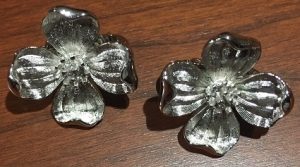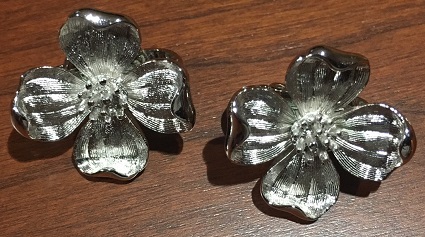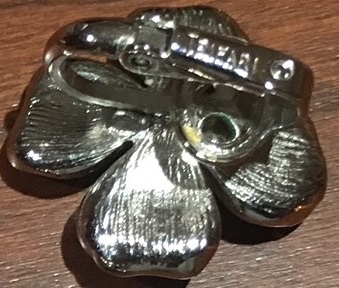
by Dr. Lori Verderame
Trifari Costume Jewelry is the namesake of its founder, Gustavo Trifari. A native of Naples, Italy, Gustavo Trifari was born to a family of goldsmiths. He established the Trifari firm in 1910. In the early part of that decade, Trifari worked with his uncle under the company name of Trifari and Trifari. Gustavo Trifari continued to make jewelry under the Trifari name when his uncle left the firm. By 1925, the firm was called Trifari, Krussman, and Fishel based on a business association with Leo Krussman and Carl Fishel.
Most traditional Trifari pieces of costume jewelry resemble fine jewelry pieces. The difference was that the Trifari pieces were made with different materials in terms of quality. Trifari’s vision was in contrast to the period designs of Coco Chanel and others who were making big, bold statement pieces of costume jewelry. Trifari Costume Jewelry is made of materials that differ from fine colored gemstones, old pawn Indian jewelry, valuable pearls, etc. Trifari pieces use an array of materials like rhinestones, coral, enamel, jade, and colored stones set in metal settings. Many costume jewelry designers like Kenneth Jay Lane, Renoir and Matisse, Miriam Haskell and others designed pieces that showed a similarity to Trifari pieces but time and again, the Trifari pieces stand out for their fine craftsmanship, unique designs, and overall understated beauty.

The designers at Trifari were trained and worked for the high end and elite fine jewelry firms of the mid 20th Century. The lead designer at Trifari from 1930 to 1968 was Alfred Philippe. During this period of design, style, and market dominance for Trifari, Philippe introduced high level craftsmanship and invisible settings to the costume jewelry line. Alfred Philippe taught his fellow Trifari designers the same fine jewelry-making techniques that he learned at the elite and prestigious jewelry firms of Cartier and Van Cleef and Arpels.
What to Look For

While you cannot tell everything from a mark on a piece of jewelry since many marks are faked but you can start by learning what an authentic mark should look like. Trifari signed and/or marked all of the firm’s costume jewelry, so look for the identifying mark. Back in the day, the Trifari firm reminded customers of their commitment when it advertised that “If it isn’t signed, it isn’t Trifari.” Authentic Trifari costume jewelry has a Trifari mark however over the years, the Trifari marks have changed. From the mid 1920s until about 1930, Trifari costume jewelry was marked with a “KTF” logo featuring an oversized central letter “T” which stood for Trifari. By the 1930s, the most common mark for Trifari pieces was the “TRIFARI PAT. PEND.” mark. This mark was used from the early 1930s. In the late 1930s, the “TRIFARI PAT. PEND. mark was used along with the Crown Trifari mark which showed a crown atop the letter “T” for Trifari from 1937 to 1955.
By the 1940s, Trifari searched for new materials as metal rationing took place during World War II. Metal rationing during the war prompted the Trifari firm to design costume jewelry pieces in precious metals as opposed to less expensive pot metals and the like. Of course, making costume jewelry pieces in sterling silver and other metals impacted the sales price for Trifari’s costume jewelry. At this time, Trifari made pieces that had the look of diamonds. They called these pieces “Diamante” and the designs were set in metals that looked like gold, platinum, and silver.
Popular Trifari costume jewelry themes and subjects during the 1940s included patriotic symbols, flags, eagles, and the ever popular Jelly Bellys. Jelly Belly pins were so named for the solid Lucite pearl belly of the figural animal or insect piece introduced by Trifari. For the Jelly Belly designs, in the animal’s belly of the pin was placed a solid Lucite pearl and today collectors seek out these valuable pieces paying a great deal for them.
Like the popular Jelly Belly pins, Trifari also offered another innovative design called Clip Mates which were dress clips that did double duty as brooches. When the two piece Clip Mates were united, the pieces served as a large brooch. When separated, Clip Mates could be used as two dress clips.
Trifari was also known for designing and manufacturing crown pins with individually set rhinestones and featured colorful cabochons–a shaped, carved, or polished stone with a flat back and a rounded front. These cabochons replaced more labor intensive faceted stones.
After the war, Trifari returned to the use of cheaper metals for its costume jewelry designs in the 1950s. For instance, the Trifari firm invented an inexpensive metal called Trifanium which had a finish that did not require polishing. Circa 1955, Trifari introduced a mark known as its Crown Trifari mark with a copyright symbol which was used from 1955 to 1969. The Crown Trifari mark was notably found on the Trifari firm’s well known and wisely marketed fruit and vegetable pins which were worn alone or in groups.
From the 1970s to the late 1980s, the Trifari firm marked pieces with “Trifari” and the copyright symbol. By the late 1980s to 2000, the most common mark on a piece of Trifari costume jewelry was the “Trifari TM” mark. In 2000, everything changed when Trifari was sold to the company known as Liz Claiborne and the jewelry was then made overseas.
Get an online appraisal of your Trifari Costume Jewelry from Dr. Lori.


